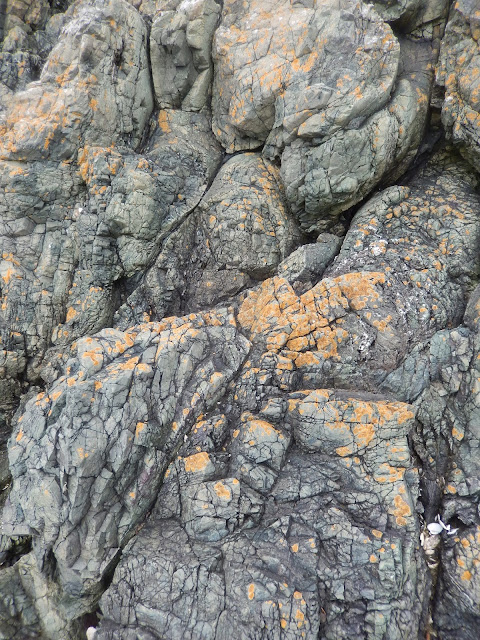 |
| Replica of slave chain found at Llyn Cerrig Bach |
 |
| Iron age artefacts |
The History Gallery also contained finds and information about other aspects of Ynys Môn history and pre-history, including the Battle for Ynys Môn during the Roman invasion of the island circa 60AD.
 |
| Station sign, with approximate pronunciation |
| Translation of the name |
After coffee at a café, we headed off to Ynys Llanddwyn, a small tidal island located at the far end of a pleasant beach near Newborough Warren. On the way there, we stopped off in blustery, drizzly weather to see Llys Rhosyr, one of the Llysoedd or Royal courts of Llywelyn Fawr, Llywelyn the Great, Prince of Gwynedd in the 13th century. It is situated near Newborough Parish Church on the road leading to Ynys Llanddwyn.
 |
| Information board showing a reconstruction of some of the buildings on the site. |
 |
| Part of the excavation. |
 |
| Only a quarter of the site has been excavated at this time. |
The name Llanddwyn means ‘The church of St. Dwynwen’. Dwynwen is the Welsh patron saint of lovers, making her the Welsh equivalent of St. Valentine. Her feast day, 25 January, is often celebrated by the Welsh with cards and flowers. After various trials, as she tried to unite with her lover, Dwynwen retreated to the island to live the life of a hermit. There are ruins of her chapel on the island but, unfortunately, the tide was coming in after our walk along the beach and we couldn’t get to the island.
 |
| View of Ynys Llanddwyn as we walked along the beach, the drizzle having abated for a while. |
 |
| The tide coming in |
 |
| Another one of my texture/colour studies |
On the way back, we took one of the many paths through the sand dunes and discussed the vegetation and the birds around us. One thing I got out of the experience was the smell of gorse—like vanilla or coconut. For all my time in Wales and my interest in its flora, so I could use it in my writing, I realised I had paid more attention to the visual environment around me than to the other senses. Our conversation revealed the differences between two plants of similar colour blooms:
 |
| Gorse thicket near Aberystwyth |
 |
| Gorse Inflorescence (source) |
 |
| Gorse Spines (source) |
 |
| Broom (source) |
 |
| Broom flowers @ Ray Woods/PlantLife (source) |
Afterwards, we went to The Ship Inn (formerly called Cei Bach, Little Quay and Hen Cei, Old Quay) at Red Wharf Bay for a late meal and discussions, with sampling, about whiskies and their trips to Speyside and Islay for various whiskey festivals and distilleries.
 |
| The Ship Inn (source) |
We then parted ways, Anna and Steve to head back to Wrexham and I drove back to the Harbour Hotel for my last night on Ynys Môn.






you can eat the gorse flowers – did u try them ?
HI Lee, I didn't get to eat them. I will try them the next time I come over. All the best. Cheers, Earl